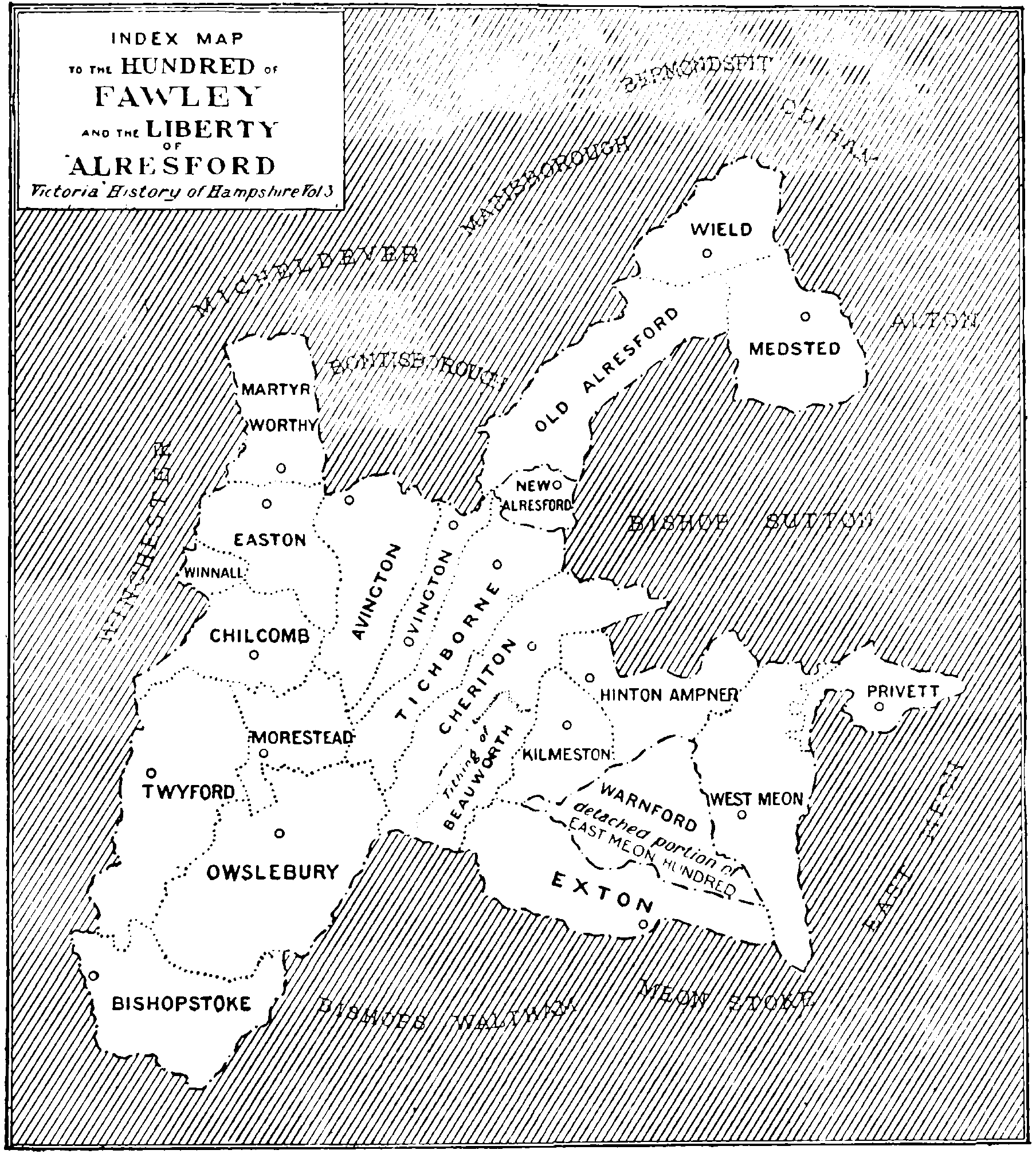A History of the County of Hampshire: Volume 3. Originally published by Victoria County History, London, 1908.
This free content was digitised by double rekeying. All rights reserved.
'The hundred of Fawley with the Liberty of Alresford: Introduction', in A History of the County of Hampshire: Volume 3, ed. William Page (London, 1908), British History Online https://www.british-history.ac.uk/vch/hants/vol3/pp302-303 [accessed 30 April 2025].
'The hundred of Fawley with the Liberty of Alresford: Introduction', in A History of the County of Hampshire: Volume 3. Edited by William Page (London, 1908), British History Online, accessed April 30, 2025, https://www.british-history.ac.uk/vch/hants/vol3/pp302-303.
"The hundred of Fawley with the Liberty of Alresford: Introduction". A History of the County of Hampshire: Volume 3. Ed. William Page (London, 1908), British History Online. Web. 30 April 2025. https://www.british-history.ac.uk/vch/hants/vol3/pp302-303.
THE HUNDRED OF FAWLEY WITH THE LIBERTY OF ALRESFORD
CONTAINING THE PARISHES OF
| OLD ALRESFORD | KILMESTON | TICHBORNE |
| AVINGTON | MARTYR WORTHY WITH CHILLAND | TWYFORD |
| BISHOPSTOKE | WEST MEON | |
| CHERITON WITH BEAU-WORTH | MEDSTED | WIELD |
| MORESTEAD | WINNALL (fn. 1) | |
| CHILCOMB | OVINGTON | |
| EASTON | OWSLEBURY WITH BAYBRIDGE | THE LIBERTY OF ALRESFORD |
| EXTON | ||
| HINTON AMPNER | PRIVETT |
At the time of the Domesday Survey the hundred of Fawley (Falelie, Falley) included Alresford, Kilmeston, Twyford, Owslebury, Easton, Bishopstoke, Chilcomb (which included Winnall and Morestead), and Avington; the amount of the land assessed was 89 hides, Alresford alone being rated at 42 hides. (fn. 2)
West Meon and Exton, afterwards in Fawley Hundred, were at this time in Meonstoke Hundred; and Ovington, part of Wield, and Hinton Ampner were part of Mainsbridge. The land in these five places was assessed at 38 hides. Privett, Tichborne, Cheriton, Martyr Worthy, and Medsted are not mentioned in the Domesday Survey; but Privett was probably included in West Meon, Medsted and the rest of Wield in Alresford, and Tichborne possibly in Twyford.
By 1316 the hundred had practically assumed its modern proportions except that Havant and Alverstoke were assessed as part of Fawley. (fn. 3) Havant was still rated in Fawley in 1465, for in that year the tithing-man of Havant paid a fine at the hundred court of Fawley to have release from suit of court of four men until Michaelmas. (fn. 4) In an exactly similar way, Old Alresford, Medsted, and Wield, which formed part of Alresford liberty (q.v.), still continued to be assessed with Fawley, and sent tithing-men to the Fawley hundred court. Consequently, therefore, when the bishop ceased to hold his Alresford hundred courts, Old Alresford, Medsted, and Wield were again reckoned in Fawley Hundred, and the term 'Alresford liberty' was taken to comprise merely the borough of New Alresford, as in the population returns for 1831.
In 1841 Headbourne Worthy parish was included in the hundred of Fawley, (fn. 5) and still remains so. Medsted and Wield, on the other hand, had become separated from Fawley and attached to Bishop's Sutton Hundred; (fn. 6) Privett was included in East Meon, (fn. 7) and West Meon and Exton in Meonstoke Hundred. (fn. 8)
In the reign of Edward III a tax of a fifteenth and a tenth levied on the country produced £28 from the hundred of Fawley, (fn. 9) a similar tax levied in 1558 produced £28 8s. 1d., (fn. 10) and in 1623 the same amount. (fn. 11)
The hundred of Fawley was held by the prior and convent of St. Swithun, and by a charter of 1284, confirmed in the following year by King John, the bishop of Winchester gave up for himself and his successors all claim to the hundred. (fn. 12) The bishop nevertheless seems sometimes to have held the hundred court, (fn. 13) and after the Dissolution it evidently passed into his possession.

INDEX MAP to the HUNDRED of FAWLEY and the LIBERTY of ALRESFORD